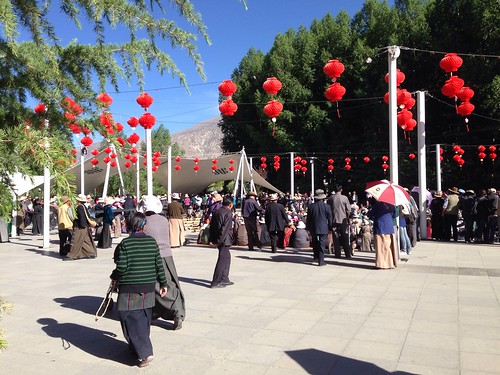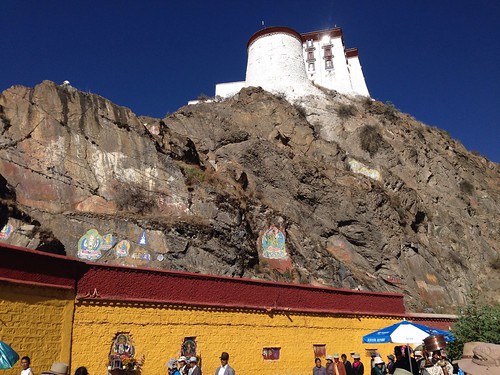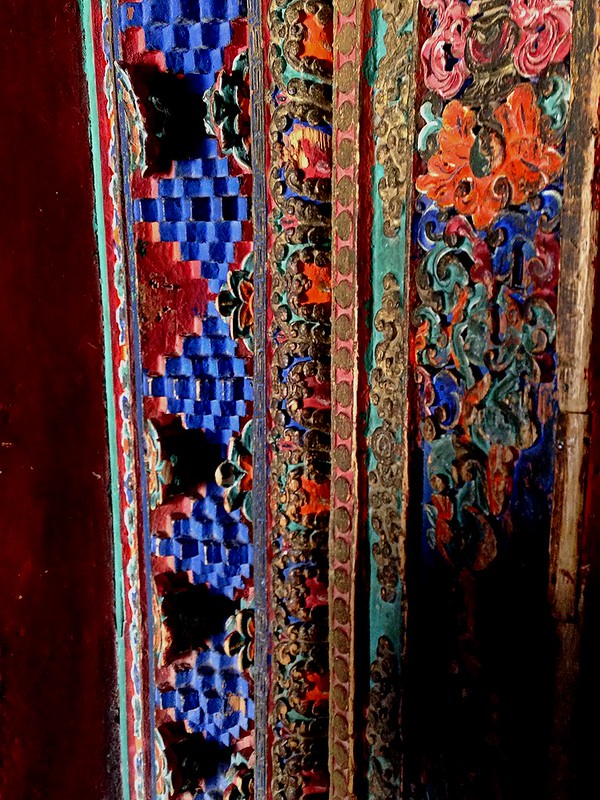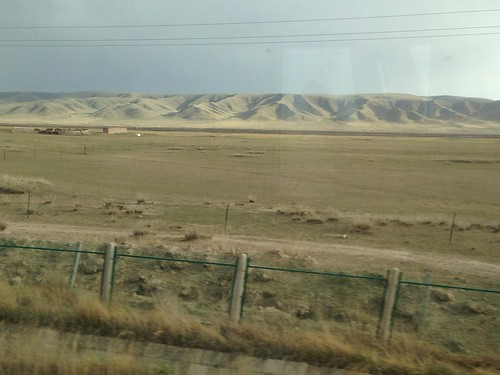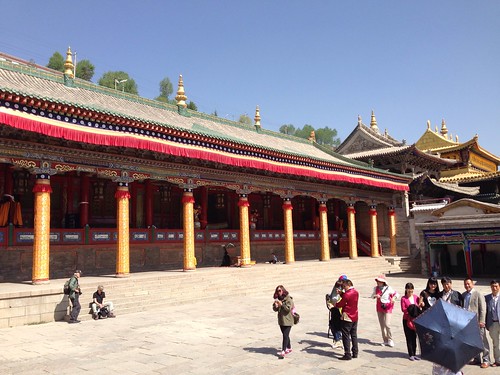I realize I have been silent for a long time. I have not lost my desire to blog, don't worry. I just have been incredibly busy at work. Since the beginning of April I have only been home a week here and there. Most of the travel has been business travel but there were two vacations, which are now added to my blog backlog.
But I want to give you a description of the trip we just took. Photos will come later as I need to organize them. I didn't want to wait to record my first impressions so here's a text only post.
We went to Tibet for 6 days. I was very nervous - nervous about the altitude, nervous about bathrooms (yes, I am picky about those), nervous about falling ill. You see, we took a 4 day cruise on the Yangtze river in April and I came home with a horrible case of food poisoning that lasted 4-5 days and needed antibiotics to end it. Fortunately that started right as we returned so I was home for most of the illness. I was afraid that it might repeat while traveling. My fears were all unfounded.
We flew to
Xining, which is in a province to the north and east of Tibet. Its altitude is 2200 m/7200 ft. We visited a lovely monastery there - called the
Kumbum or Ta'er - which is the birthplace of the founder of the
Yellow Hat sect of Tibetan Buddhism. The Dalai Lama is the current head of the Yellow Hat sect. Our objective was to start getting used to the altitude gradually. It was tough. The monastery sits on a hill (as many of them do) and climbing was hard, but we took it easy.
Later that afternoon, we took the
train to
Lhasa. It is a 24 hour train ride that goes over a pass that is 5072 m/16640 ft. I thought I would die as we boarded the train. We kept trying to get to the platform early but the train staff wouldn't let us. Then, when the train pulled in, we found we had to haul our suitcases up a flight of steps and then the length of the platform as we looked for our coach. With the higher altitude in Xining, this meant my heart was racing and I was gasping for breath. But we made it.
We had a soft sleeper which means two berths, one above the other; 4 to a compartment. We were told that the service was good but we didn't notice any service at all. There are announcements about the landscape and locations in Mandarin and English. The service consisted of ticket-checking, passport/permit checking and that was about it. Foreigners have to have a travel permit in addition to a Chinese visa to visit Tibet and have to go with a travel agency - no solo trips.
Oxygen is pumped into the train as it goes over the high pass and we were told we'd get oxygen masks in case the oxygen mixed with the air wasn't enough. No masks materialized, but fortunately we didn't need them! The train provides pillows, sheets and blankets. We had packed food (over packed food) but neither of us had much appetite so we didn't eat much. We tried to drink a lot of water as hydration is important to avoid altitude sickness. We were also taking
Diamox for the same reason.
The scenery was everything we had expected. We started in grasslands that fed sheep and cows. Then there were tall mountains, flat plains - mostly devoid of trees - with lots more sheep and yaks, and lakes. I brought books, cards and knitting/spinning to occupy the time but spent it mostly looking at the scenery and taking photos.
On arrival in Lhasa, I experienced my next near-death experience. On the train, we pretty much weren't doing much. But when we got to Lhasa, we had to walk, dragging our suitcases, through a huge, brand-new station, to a police checkpoint where they made copies of our passports, and then out along a long path to where the guide was waiting. Then we had to go a quarter of a mile or so to the car-park. It was around 4 pm and sunny and HOT! Between that and the 3490 m/11450 ft altitude, I was breathless and exhausted. All we did though was go to the hotel and rest. But walking to dinner was taxing.
On the morning of the third day, we want to the
Potala Palace - the winter home of the
Dalai Lama - if he was in Tibet. Most of Lhasa is flat but the palace is on a hill. And then there are 13 floors of the palace to climb! We took it slowly but were very tired once it was done. The palace was everything I expected and more. Gorgeous views, incredible treasures, sanctity and antiquity. It was poignant to see a picture of the thousand-armed
Avalokitesvara - the Buddha of Compassion - instead of the Dalai Lama.
After lunch we went to the
Jokhang temple - which was mercifully flat. I felt really calm and serene in these places, which have had centuries of worship in them. The temple contains
a statue of the Buddha which is said to be over 2000 years old - blessed by the Buddha himself. It is the heart of Tibetan Buddhism.
We went to
Shigatse by car the next day, climbing over 3 high passes which are around 5000 m. We didn't do much at any of them except get out and take photos. Therefore, there wasn't any altitude issues except for the fact that just getting in and out of the minivan caused hearts to race. It was an 8 hour drive over windy mountain roads with bumps due to frost heaving. We made a brief stop at
Gyantse to visit another monastery.
The hotel was quite modern but it was on a main road so it was very noisy and I couldn't open the windows due to the noise. The room was warm so sleep was tough. Tibet gets quite warm during the afternoon - up to 28C/80F - but cools down to 11C/50F at night. The sun is very hot due to the altitude.
Our next visit was to the
Tashilhunpo monastery, home to the
Panchen Lama. The Panchen Lama is second only to the Dalai Lama. The current Panchen Lama is in Beijing but the monastery has the same air of veneration and sanctity that the Potala Palace and the Jokhang temple have. There was climbing here and it wasn't easy but it was getting easier. And it wasn't as high as the Potala Palace!
We then headed back to Lhasa by a flat road that wound along the
Brahmaputra river. It was not a bad drive but there are many police checkpoints along these roads. Sometimes they want to see our travel permits and passports. At other times, they assign a time span to cover a certain distance (40 km in 55 mins) and you have to make sure you don't get to the next checkpoint earlier than that or risk a fine. This meant stopping at various pop-up rest areas and waiting for time to pass before heading out again.
Our last morning in Lhasa was spent at
Norbulingka, the summer palace of the Dalai Lama. Right before the current Dalai Lama left Tibet, he had just moved into new living quarters here. We saw where he slept, where he meditated, the old-fashioned radio in his sitting room, the room where his mother stayed when she visited (remember, he left home really young to be reared in the monastery), his bathroom, his throne and assembly hall. There is even a painting of him on a wall - the only picture of him anywhere.
Then it was time to fly home.
It is a holy month in Tibet as the Buddha's birth and enlightenment anniversaries occur during this month. The name of the festival is
Saka dawa and as a result, there were many people at the monasteries and temples. Tibetans are very devout - offering money and butter (for lamps) as well as prostrating themselves and walking clockwise circuits around the holy places (
kora). Some of them even prostate themselves around the circuit. They have a prayer wheel in one hand and a string of beads in the other - chanting and praying as they walk or sit. Because of the festival, many of them were wearing
traditional dress, so it wasn't unusual to see a young woman in traditional dress, high heels and a purse.
I was afraid we wouldn't get vegetarian food but it seems many Tibetans are vegetarians these days. Also, due to the festival, many of them are vegetarian this month. So food was not a problem at all. I didn't have much appetite but our regular Lhasa restaurant had a good selection of vegetarian Tibetan, Nepali and Indian dishes, which meant I could get exactly what I felt like. Lunch on vegetable
momos, dine on dal makhani, breakfast on fresh yogurt and unfiltered honey. They even eat yogurt and rice, like us South Indians! It wasn't the greatest food but it was tasty and readily available close by and you can't beat that combination.
It is good to be back at sea level again. I am glad I had the opportunity to visit
Photos will come with time as will photos and write-ups on the other trips that I am still working on. I know I left you in the middle of Australia and part-way through Tokyo but I need to do something better with the photos before I continue. There are just too many of them and I have to find a good organization system so I can find them when I want them. Thank you for staying with me!
There hasn't been a lot of fiber work either. I have been slowly trying to finish up last year's TdF project before this year's starts. I also knitted part of a shawl and ripped it out today because I am not enjoying the lace. I will start another one today or tomorrow with the yarn.

